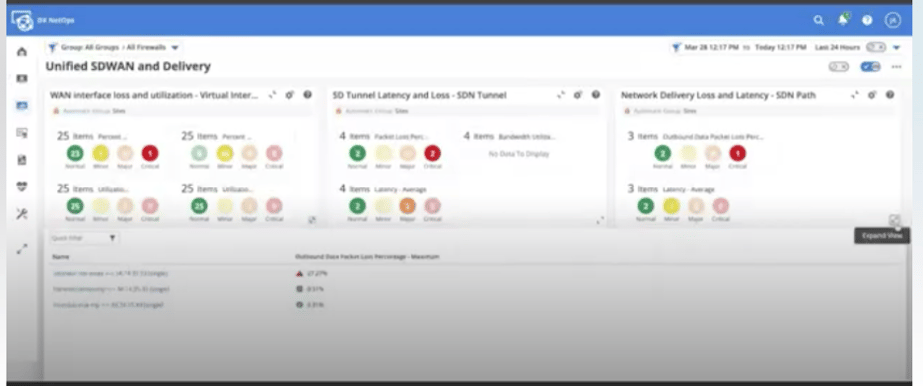October 25, 2023

SD-WAN Performance and User Experience: Gaining Unified Visibility with DX NetOps

Written by: Jason Normandin
As the use of SD-WAN continues to expand, benefits and challenges may seem to be proliferating in equal measure as well. In this post, we look at some of the advantages and obstacles presented by SD-WAN, and we detail how DX NetOps by Broadcom delivers the visibility teams need to monitor and manage their SD-WAN and legacy network environments.
The promise of SD-WAN
On the plus side, teams that employ SD-WAN are realizing significant advantages. They’re able to expand WAN bandwidth and achieve improved application performance across the WAN. At the same time, they’re doing so while leveraging commercially available technologies that enable improved cost efficiency.
As a result, SD-WAN helps teams be better equipped to address their organization’s demands for rapid scale and adapt to evolving hybrid work and cloud adoption realities.
The roadblocks presented by SD-WAN
While the promise of SD-WAN is real, so too are the potential roadblocks.
In SD-WAN environments, native monitoring tools can fuel explosive growth in event volumes, while leaving blind spots in visibility. These native tools only offer coverage from WAN edge to WAN edge; they don’t provide end-to-end visibility from where users connect. Also, these SD-WAN tools only provide visibility into the overlay, namely tunnel performance, but don’t provide insights into how and where the physical underlay may be impacting the overlay.
Further, when teams add these native tools to their environment, it means they have more disconnected tools to work with. This means they have to spend more time and effort to piece together the insights they need, stifling productivity and efficiency. (For more information on the challenges of SD-WAN monitoring, see my recent post, SD-WAN Monitoring: Why Edge-to-Edge Coverage Isn’t Enough.)
To combat these obstacles, while capitalizing on SD-WAN’s advantages, teams need a unified tool that can power more simplified standard operating procedures and fuel faster issue resolution.
DX NetOps delivers the coverage, visibility required
DX NetOps enables teams to eliminate the monitoring roadblocks presented by SD-WAN. DX NetOps delivers the correlated intelligence that enables teams to effectively track, manage, and optimize their SD-WAN and legacy environments.
DX NetOps enables teams to establish holistic visibility and effective baselines, so they can distinguish between optimal and suboptimal performance. In addition, with AppNeta by Broadcom, teams can gain an end-to-end understanding of network performance, no matter where users or critical business apps may be.
DX NetOps dashboards provide a unified view
DX NetOps enables teams to gain unified views of their entire environment, from end to end. DX NetOps brings together data on SD-WAN performance, physical underlay performance, and network delivery.
Teams can build a single dashboard with information on SD-WAN tunnels, edge ports, and AppNeta network delivery paths. The solution can bring together data from a range of sources, including AppNeta, AWS, Cisco Application Centric Infrastructure (ACI), OpenStack, Versa, Viptela, and VMware.
DX NetOps enables operators to quickly get high-level, intuitive visibility of their environments. Further, DX NetOps offers users complete flexibility to customize dashboards, so they can position data where needed and align views with the context of their specific environments and objectives.
How it works
Visibility of end-to-end SD-WAN environments and experience is enabled via AppNeta paths and the concept of sites in DX NetOps.
Virtual Network Assurance (VNA) is used to collect data from SD-WAN technologies. VNA creates a user group hierarchy for each plugin instance. (For those familiar with DX NetOps, there is a consistent structure and approach across different plugins, so this SD-WAN hierarchy will resemble that of other technologies being monitored.)
Within DX NetOps, a pinning technique is used to enable the presentation of unified dashboards that reflect views of multiple technology domains.
DX NetOps incorporates all associated edge devices, and can include both primary and secondary systems. Users can look at SD-WAN devices in inventory, and view by location.
Here are some of the key elements of the environment:
- Sites. Sites are automatically created for SD-WAN and AppNeta delivery, the latter based on monitoring points and targets.
- Groups. Site groups represent source and destination targets. When communicating with controllers, DX NetOps polls edge routers. All devices can be coalesced into site groups. Group names are created automatically, but can be modified in DX NetOps.
- Geolocation. Upon device discovery, DX NetOps automatically assigns longitude and latitude. This makes it easy to group elements by region and to view devices on a map. Based on this geolocation data, teams can also add region-specific information, such as time zones, office hours, and so on.
- Folders. DX NetOps creates folders that are specific to each type of technology. These folders feature a list of monitoring points and targets and details being gathered.
Network delivery
When it comes to network delivery, DX NetOps offers a range of useful capabilities. With the solution, teams can look at outbound data packet loss, and they can view averages or maximum. One approach that we commonly see customers employ is to create views that display both averages and maximums, which is useful in tracking the high-water mark of a given device.
When users go to the VNA domain folder, they can select specific sites, which will contain all the grouped monitoring points, targets, and paths. These tech folders make it easy to drill down into all devices in a particular domain, for example, a user can filter in order to see only Viptela controllers. This visibility can provide powerful insights. For example, a user can view utilization metrics for a specific region, and quickly see metrics for a specific interface are extremely high.
Dashboard creation, customization
To start creating their own dashboards, users can go into the “My Dashboard” console and build and modify dashboards for their personal use. [In the future, Broadcom will make it easy to create dashboards in My Dashboard console, and share them with other teams or users. Currently, have to manually recreate or share via REST API.] For example, with DX NetOps, it is easy to build a card view that displays latency, loss, and utilization across different tiers.
In creating dashboards, users can select from different layouts. For example, a commonly used layout is one that has three card views at the top, two graphs on the second row, and a single graphic on the final row. Card views provide counts of the number of items in a group that meet specific criteria, such as exceeding a threshold.
Users can assign specific thresholds, for example, for interface utilization dashboards, they can have can thresholds set at 85% for minor, 90% for major, and 95% for critical.


Conclusion
With DX NetOps, teams can establish visibility from the edge out, not based on data from SD-WAN controllers, but from AppNeta synthetic network testing. This enables operators to validate and correlate performance issues, and spot where an issue is originating—no matter where users are located or which networks are being used.
To learn more, please see our Small Bytes webcast, How to Create Unified SD-WAN Dashboards to Understand End-to-End Experience. Also, be sure to view our Small Bytes page to see a complete list of upcoming and on-demand presentations in the series.

Jason Normandin
Jason Normandin has over 17 years of experience in the Network Performance and Fault monitoring industry. Focusing on User Experience, APIs and new technologies Jason drives to provide simplicity to complex technologies and insights into today’s massive data repositories.
Other resources you might be interested in
Automic Automation Cloud Integration: SAP Integration Suite Integration
Instantly inherit the advanced capabilities of your enterprise solution, enabling you to deliver your digital transformation more quickly and successfully.
Automic Automation Cloud Integration: Azure Power BI Agent Integration
Learn to integrate Automic Automation with Azure Power BI to schedule refreshes, monitor jobs, and orchestrate cloud workloads from a single interface.
ValueOps ConnectALL: Creating a Universal Adapter
This course helps you understand the complete workflow for creating a Universal Adapter in ValueOps ConnectALL.
AAI - Monitoring Jobstreams Using Business Areas
Learn how business areas help you organize and focus your monitoring in AAI. Find out where business area filters appear and how to refine your daily views.
Rally Office Hours: January 8, 2026
Learn about using the capacity forecasting screen and Monte Carlo simulations in Rally. The session also includes a Q&A segment covering topics such as tracking work handoffs with tasks or custom...
DX NetOps Smarts: Overview
Learn how DX NetOps Smarts discovers hybrid environments to map complex topologies, then provides unified real-time monitoring with advanced fault management and automated root-cause analysis.
Top 3 Trends Defining Network Observability in 2026
Discover the three specific trends that will define network observability in 2026. See how unified observability and predictive AI will shape the landscape.
Rally Office Hours: December 18, 2025
Rally Office Hours features an AI-driven artifact breakdown tool that creates child items from features/stories. The Q&A covers capacity planning, forecasting and burnup charts.
Why 2025 Shattered the Old Rules of Network Management
This post reveals the five key lessons network operations leaders learned in 2025—and how they need to respond to be successful in 2026.